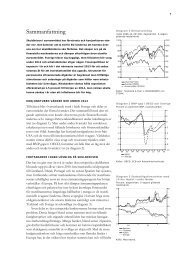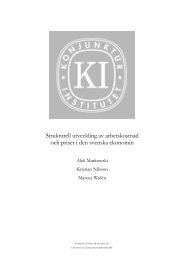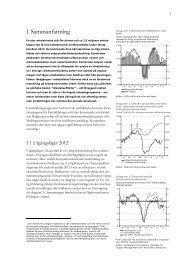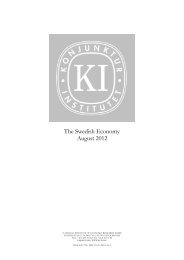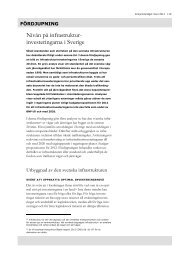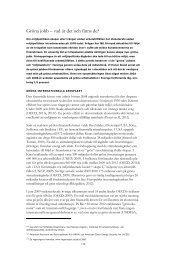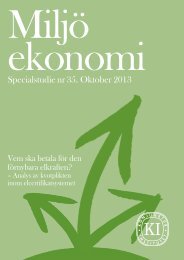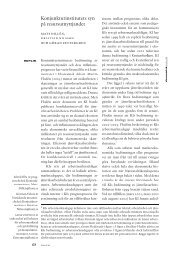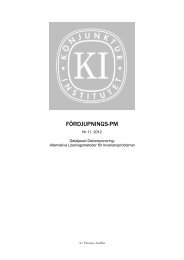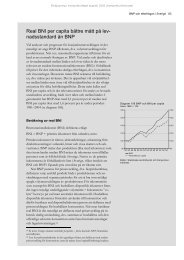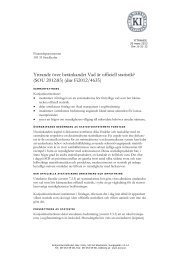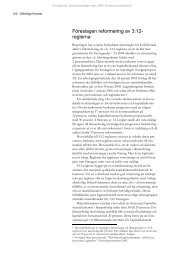Central Bank Forecasts of Policy Interest Rates - Konjunkturinstitutet
Central Bank Forecasts of Policy Interest Rates - Konjunkturinstitutet
Central Bank Forecasts of Policy Interest Rates - Konjunkturinstitutet
You also want an ePaper? Increase the reach of your titles
YUMPU automatically turns print PDFs into web optimized ePapers that Google loves.
12are given in Table 1. 6 At the one-quarter horizon, there are no signs <strong>of</strong> inefficient use <strong>of</strong> data ineither country. However, looking at the results for the two longest horizons, we see that both theforecasts <strong>of</strong> the central banks as well as market expectations are judged inefficient (at the five or tenpercent level in Norway and at the one percent level in Sweden). While bias is not necessarily a sign<strong>of</strong> lack <strong>of</strong> rationality, inefficient use <strong>of</strong> data is incompatible with strictly rational expectations. However,both central banks and private agents operate with incomplete information about the economyand its dynamics, making fully rational expectations perhaps an excessively demanding benchmark.3.2 Forecast accuracyAs the last step in our assessment <strong>of</strong> the policy-rate expectations, we compare the forecasting precision<strong>of</strong> the central banks’ forecasts to the expectations inferred from market pricing. Results areonce again given in Table 1.Turning to Norway, forecast errors generally are small at the one-quarter horizon. The root meansquare errors (RMSEs) for Norges <strong>Bank</strong> and market expectations are 0.43 and 0.36 respectively.Reflecting the difficulties <strong>of</strong> forecasting, absolute forecast errors are on average larger the longerthe forecast horizon. At the one-year horizon, Norges <strong>Bank</strong>’s RMSE is 1.46 and market expectations’1.36; at the two-year horizon, the corresponding numbers are 2.18 and 2.21. As can be seenfrom Figures A2, A3 and A4, both market-inferred expectations and Norges <strong>Bank</strong> over-predictedthe future policy rate substantially before the dramatic cut <strong>of</strong> December 2008. This is particularlyevident for one- and two-year ahead forecasts in which the forecast miss affects forecast errors forseveral subsequent periods. 7 The market-inferred expectations exhibit slightly higher forecast precisionthan Norges <strong>Bank</strong>’s forecasts at the two shorter horizons but the difference is small at all horizons.Naïve forecasts exhibit the largest RMSEs at all horizons.To test if there are any significant differences in forecasting performance between Norges <strong>Bank</strong> andthe alternatives we conduct a modified Diebold-Mariano test under the assumption <strong>of</strong> a quadraticloss function. 8 This is based on the regressionCB 2 alt 2e e ,t h t t h tt(3)6 We do not test for efficient use <strong>of</strong> data when it comes to the naïve forecast. It is after all a simple benchmark andshould <strong>of</strong> course be treated as such.7 Recall that by definition the forecast error <strong>of</strong> an h-step ahead forecast is serially correlated. Even an efficient forecastfor horizon h has an MA(h-1) structure.8 We use the modified test <strong>of</strong> Harvey et al. (1997) rather than the orignial one suggested by Diebold and Mariano(1995) since our samples are fairly small.



